An outdoor kitchen is among the most desirable features for homeowners who enjoy outdoor living and entertaining. It seamlessly extends your indoor space to the outdoors, creating a perfect setting for cooking, dining, and gathering with family and friends. When thoughtfully designed, an outdoor kitchen not only adds functionality but also enhances the beauty of your landscape, allowing for year-round enjoyment—even in cooler weather.
We’ll explore tips on integrating luxurious, fully-equipped outdoor kitchens into your landscape design. From choosing the right location and materials to incorporating weatherproof features, here’s how to create a stylish and practical outdoor kitchen.
Choose the Right Location: Functionality Meets Flow
The location of your outdoor kitchen is crucial to its success. It should seamlessly blend with your home and landscape and be conveniently accessible from indoor spaces like the central kitchen or dining room. Additionally, consider the kitchen’s proximity to key outdoor features like patios, pools, or dining areas.
Critical Considerations for Location:
- Proximity to Indoor Kitchen: For ease of food prep and transport, locate the outdoor kitchen near the indoor kitchen. This reduces trips back and forth and creates a natural flow between spaces.
- Protection from Elements: Choose a location that provides natural shelter from wind or rain. If your yard is exposed, you can design a pergola, roof, or retractable awning to protect the kitchen area.
- Connection to Social Areas: Position your outdoor kitchen near outdoor seating or dining areas so the chef can participate in the conversation. This creates an interactive space where cooking and socializing blend effortlessly.
By carefully choosing the location of your outdoor kitchen, you ensure it becomes a central hub for cooking and entertaining.
Build for Year-Round Use: Design for All Seasons
An outdoor kitchen is an investment you’ll want to enjoy year-round, especially in places like Atlanta, where outdoor living is possible through most seasons. To make your outdoor kitchen functional in warm and cooler months, consider adding features that allow for comfort no matter the weather.
Tips for Year-Round Outdoor Kitchens:
- Heating Elements: Incorporate heating features like outdoor fireplaces, fire pits, or overhead heaters to extend the use of your outdoor kitchen into cooler weather. This creates a cozy ambiance while ensuring warmth for guests during fall and winter.
- Weather-Resistant Materials: Choose durable, weatherproof materials like stainless steel for appliances and stone or concrete for countertops. These materials withstand rain, heat, and temperature changes, ensuring longevity.
- Shade Structures: Incorporate pergolas, retractable awnings, or shade sails to protect the kitchen area from the sun during hot summers. These features can also shelter the area during light rain, ensuring the space is usable year-round.
With these elements, your outdoor kitchen can be a comfortable and inviting space, whether grilling in the summer or roasting marshmallows in the winter.
Plan for Full Functionality: Equip Your Outdoor Kitchen
For your outdoor kitchen to feel like a true extension of your home, it must be fully equipped with everything you need for cooking and entertaining. Designing with functionality in mind ensures that you have the right appliances, counter space, and storage options to handle anything from a quick dinner to a large gathering.
Outdoor Kitchen Must-Haves:
- Built-In Grill: The centerpiece of most outdoor kitchens, a built-in gas or charcoal grill is a must for outdoor cooking. For versatility, look for models with multiple burners, smoker options, or rotisserie attachments.
- Outdoor Refrigerator: A weatherproof outdoor fridge keeps drinks cold and ingredients fresh without requiring constant trips inside. Some kitchens may also include an ice maker or wine cooler.
- Countertop and Prep Space: Ensure ample counter space for preparing food, serving dishes, and organizing utensils. Stone or concrete countertops are ideal for durability and aesthetics.
- Sink and Faucet: A sink with running water makes food prep and clean-up easy. Look for stainless steel or corrosion-resistant faucets that can withstand the elements.
- Storage Solutions: Cabinets and drawers made from weather-resistant materials help store utensils, cookware, and other essentials, ensuring your kitchen stays organized.
- Pizza Oven or Smoker: For the ultimate outdoor cooking experience, consider adding a pizza oven or smoker. These elements allow you to expand your culinary options, making your outdoor kitchen a gathering spot for food enthusiasts.
By fully equipping your outdoor kitchen, you create a space that rivals your indoor kitchen in both function and style.
Blend with the Landscape: Aesthetic Harmony
Your outdoor kitchen should feel like a natural extension of your landscape. Achieving this requires thoughtful design incorporating materials, textures, and elements from your garden or patio, ensuring the kitchen blends harmoniously with the overall aesthetic.
Design Ideas for Blending an Outdoor Kitchen with the Landscape:
- Use Natural Materials: Choose materials that reflect your home’s architecture and landscape’s natural surroundings. For example, stone veneer or brick can tie the kitchen to a rustic outdoor setting, while sleek concrete or stainless steel may suit a modern home.
- Incorporate Greenery: To soften the hardscape, surround the kitchen area with garden beds, planters, or vertical gardens. Herbs like rosemary, thyme, and basil are functional additions that enhance the aesthetic and culinary experience.
- Lighting for Ambiance and Safety: Outdoor lighting is key to making your kitchen usable after dark. Use a mix of task lighting, such as under-counter or grill lights, and ambient lighting, like string lights or lanterns, to create a warm, inviting atmosphere.
- Water Features or Fire Elements: To create a luxurious outdoor kitchen, consider integrating nearby water features (like a fountain or pond) or fire elements (such as a fire pit or outdoor fireplace). These features add a sense of relaxation and help create a focal point in the landscape.
By incorporating these design elements, your outdoor kitchen will function well and enhance your landscape’s overall beauty.
Consider Layout and Flow: Designing for Socializing
The layout of your outdoor kitchen is just as important as the features you choose. A well-planned layout ensures that your kitchen is functional while also creating space for socializing and entertaining. Design your kitchen to encourage interaction between the cook and guests and ensure a natural flow between different areas of the yard.
Popular Outdoor Kitchen Layouts:
- L-Shaped Layout: An L-shaped layout maximizes counter space and creates a natural division between the cooking and prep areas. This layout works well in larger backyards and provides room for multiple appliances.
- Straight Line Layout: Ideal for smaller spaces, a straight-line kitchen keeps everything in one place, making it easy to transition between cooking, prepping, and serving. This layout also integrates the kitchen into a patio or deck.
- U-Shaped Layout: A U-shaped kitchen offers plenty of counter space and storage, making it perfect for those who love entertaining. The layout wraps around the chef, creating a semi-enclosed cooking space ideal for socializing with guests.
- Island Layout: A kitchen island can serve as a prep area and a gathering spot for larger outdoor spaces. Guests can sit around the island while the chef cooks, creating a casual, interactive environment.
When designing the layout, ensure plenty of room to move between appliances, prep stations, and dining areas. This will make the kitchen functional and enjoyable for the cook and guests.
Weatherproof and Low-Maintenance Materials: Built to Last
Since your outdoor kitchen will be exposed to the elements, choosing weatherproof and durable materials is crucial. The right materials will not only withstand the weather but also require minimal maintenance, allowing you to enjoy your kitchen more and less time maintaining it.
Recommended Materials for Outdoor Kitchens:
- Stainless Steel Appliances: Stainless steel is the gold standard for outdoor kitchens. It’s resistant to rust, heat, and weather damage, making it ideal for grills, refrigerators, and cabinetry.
- Stone or Concrete Countertops: Stone and concrete countertops are heat-resistant and durable. They’re perfect for withstanding the sun, rain, and cold without cracking or fading.
- Powder-Coated Cabinets: Powder-coated aluminum or stainless steel cabinets are attractive and durable, protecting against corrosion and ensuring long-lasting use.
- Sealed Stone or Tile Flooring: For safety and durability, choose non-slip, sealed stone or tile flooring. Natural stone options like flagstone, slate, or porcelain tiles are great options that also add visual interest.
Investing in quality materials will ensure that your outdoor kitchen remains beautiful and functional for years.
Create the Perfect Outdoor Kitchen for Year-Round Enjoyment
Integrating an outdoor kitchen into your landscape design can transform your backyard into a luxurious, functional retreat that your family and friends will enjoy year-round. By carefully selecting the right location, materials, and layout and ensuring it’s equipped with everything you need for cooking and entertaining, you can create a space perfect for summer barbecues and fall gatherings.
With the right design, your outdoor kitchen will blend seamlessly into your landscape, enhancing your yard’s beauty and usability while providing endless opportunities for outdoor dining and socializing.

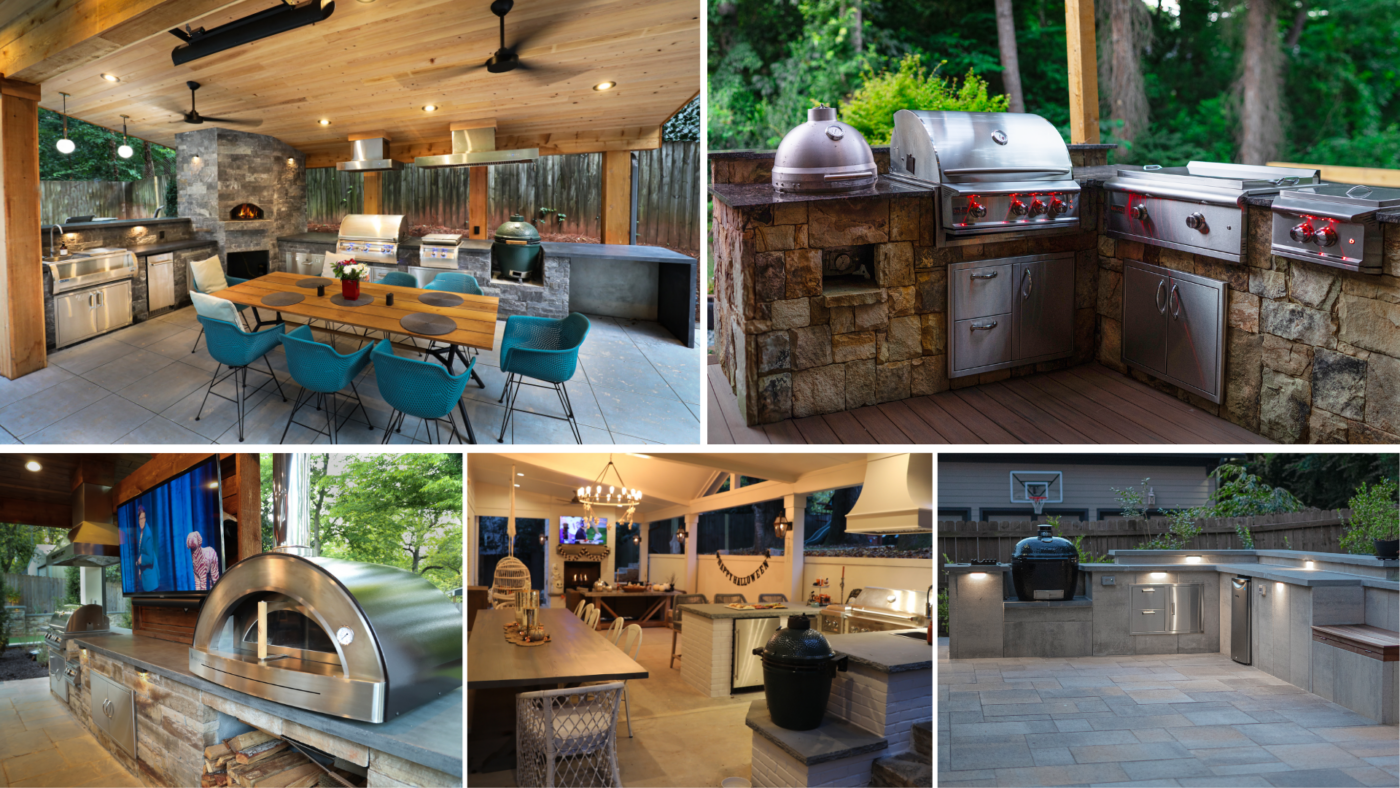
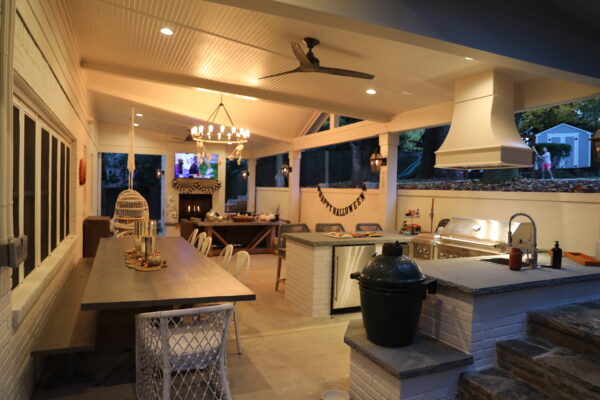
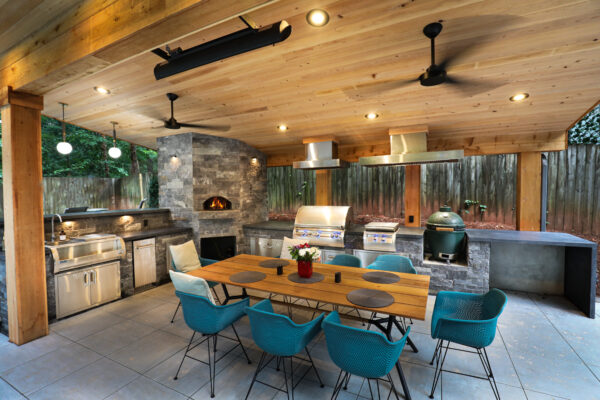

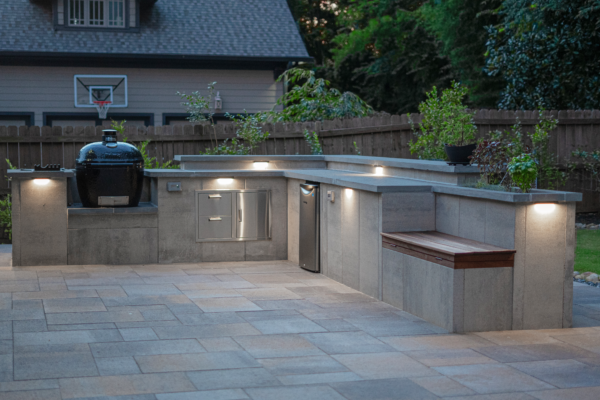
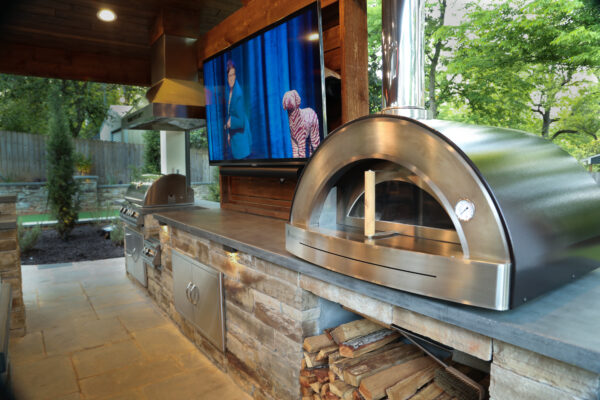
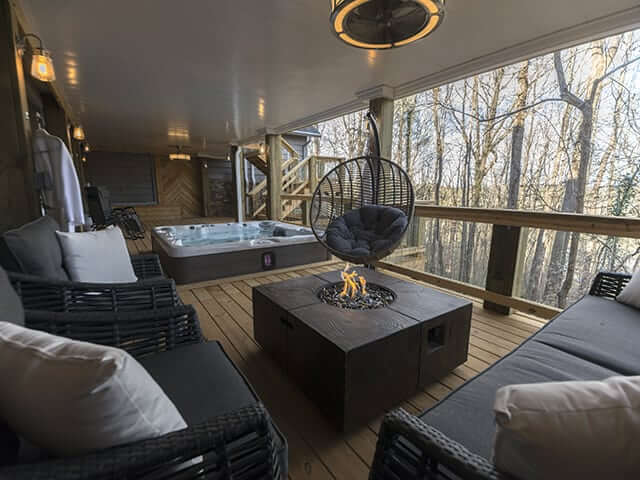 Winter-Ready Tips for Outdoor Living Spaces
Winter-Ready Tips for Outdoor Living Spaces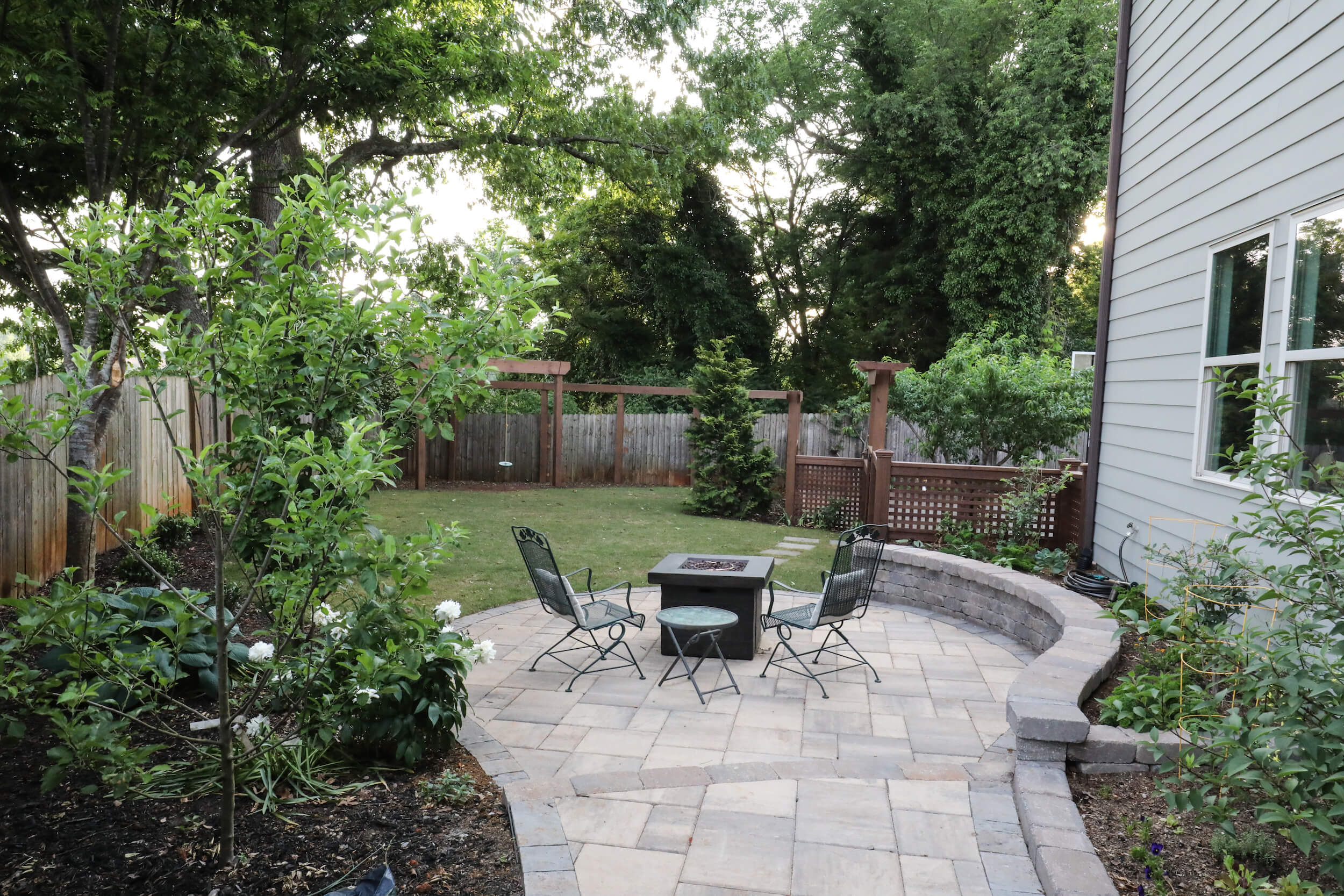 7 Tips on How to Clean Your Tiled or Paved Patio
7 Tips on How to Clean Your Tiled or Paved Patio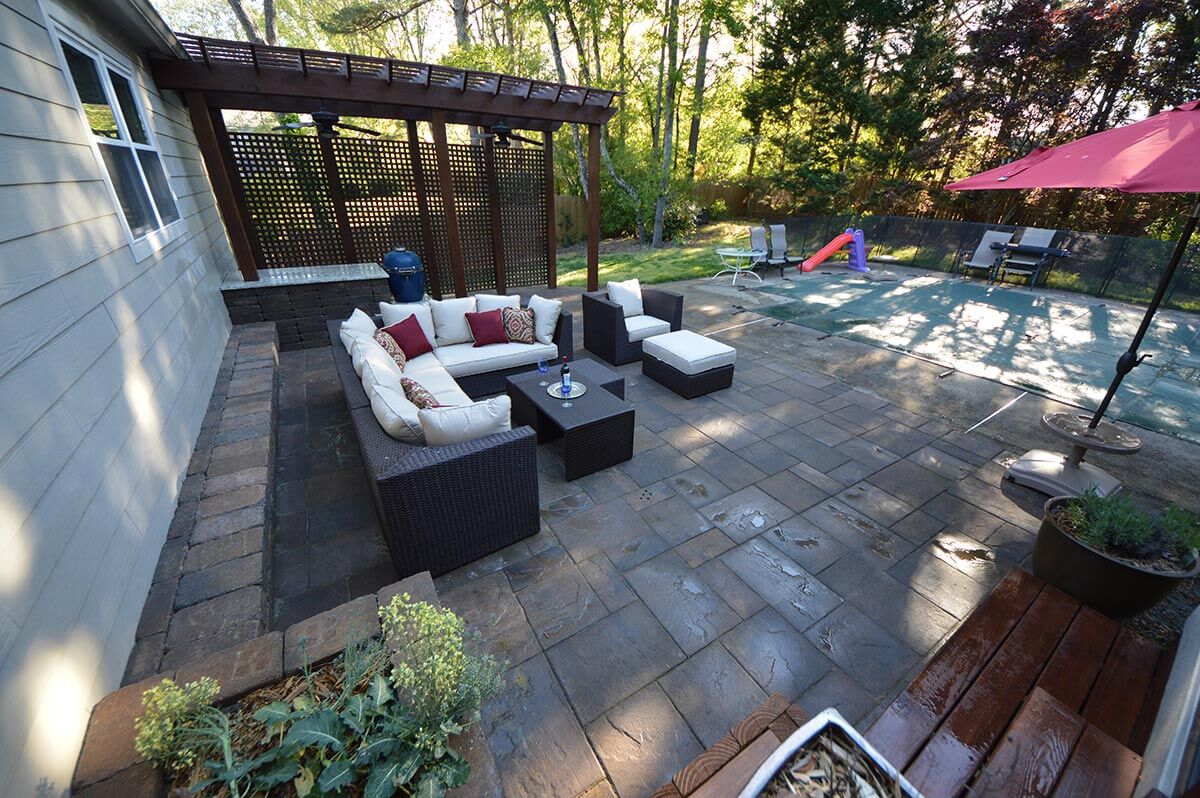 How to Keep Your Outdoor Living Space Family Oriented
How to Keep Your Outdoor Living Space Family Oriented
LET'S BE SOCIAL: